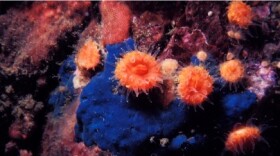The recent settlement of a lawsuit alleging that coal trains are polluting waterways in Washington and Oregon secured $1 million for mitigation projects. BNSF has also agreed to pay for cleanup of spilled coal in five sites along the Columbia River Gorge.
But the watchdog groups behind the suit say the court’s order for a study of the use of physical covers for coal and petroleum coke trains may have the most impact.
Seven environmental groups, including the Sierra Club and Columbia River Keeper, first brought the suit four years ago, seeking damages of $4.6 trillion. That was based on what they thought were appropriate fines for repeat violations of the Clean Water Act as BNSF coal trains traveled alongside Washington’s waterways over a five-year period.
However, Chris Wilke with the Puget Soundkeeper Alliance says it was never really about the money. Their aim was to stop the pollution.
“The best solution is to end the discharge completely. And that involves covering the cars,” Wilke said.
BNSF admits no wrongdoing in the settlement. The company says right now, it has the best technology available to keep as much coal and petroleum coke dust as possible from spilling as it moves down the track. It loads cars at the mines in the shape of a loaf of bread and then sprays the coal in place with a glue-like topping agent.
Two years ago, BNSF added a respraying facility in Pasco, Wash., to give added protection as the trains enter the state and head through the Columbia River Gorge toward the West Coast. The company has a YouTube video of the respraying facility on its web site.
https://www.youtube.com/watch?v=EYpYOfMFBAI
But Wilke says citizens groups like his have shown it's not working. They say dust and pieces of coal still fly off the tops of the cars or are carried with water seeping out of the bottoms, and then enter Washington's waterways.
“The key element here was the evidence that was collected by staff and volunteers from the plaintiff organizations,” Wilke said, explaining that they collected samples of coal they found beneath the high-tide line and beneath the ordinary high-water mark along the rivers.
“And we documented extensive waterways that were impacted by coal and some areas with significant accumulations,” he said.
BNSF spokeswoman Courtney Wallace says the settlement was a better solution than spending years in a protracted lawsuit. And she says the company wants to continue on the forefront of whatever solutions allows them to move their freight the most efficiently - whether it's coal or grain or consumer goods.
"So, whether it is coal-cover tops or another technology, I think what you'll see is, as the railroad continues to look at the available opportunities out there, that the program will continue to evolve," Wallace said.
There are still questions about whether coal car covers are mechanically feasible and commercially viable. But the environmental groups behind the suit say there are manufacturers waiting in the wings to test their technologies. Their hope is that after the two-year study that was ordered by the court, the covers will be introduced here, setting a precedent for the industry nationwide.







